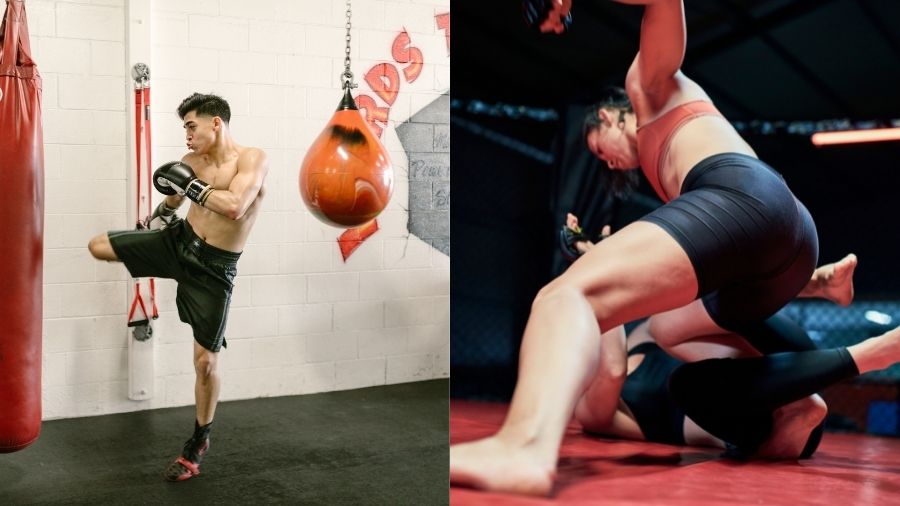While kickboxing has taken a step back in popularity as opposed to MMA, it’s still a very relevant and entertaining combat sport, with numerous academies teaching it worldwide.
Choosing a “better” martial art is pretty much impossible, as many criteria are subjective. On top of that, each person is unique, and their goals are the most important factor in choosing which is better.
Kickboxing is a pure striking martial art combining punches and kicks. MMA is a mixture of many martial arts from the striking, wrestling, and grappling realms, including kickboxing.
Your motivations are the key when choosing what to train. Still, in this post, we will help you by showcasing the main differences between MMA and kickboxing.
What Is Kickboxing
Kickboxing is a stand-up combat sport in which punches and kicks are used. Many martial arts combine these two, but the sport we call kickboxing originated in Japan. Karate practitioners in the 1960s saw the lethal effectiveness of western boxing and Muay Thai.
Still, they wanted to keep the spirit of karate, so they created a hybrid of the three, and kickboxing was born.
You may be surprised at the similarities between the origins of modern MMA and kickboxing. They were heavily popularized by answering the eternal questions in martial arts- which martial art is the best.
The organization that brought worldwide fame to kickboxing was K1. Their formula in the 1990s was very similar to that of the UFC, only limited to striking martial arts.

How to Dominate Every Fight with Raw, Explosive Power No One Can Match
Discover the underground blueprint that has quietly turned MMA hopefuls into legends, using nothing but sheer, brute force and bulletproof conditioning techniques.
But K1 matched the main attractive arts between karatekas, Muay Thai fighters, boxers, taekwondo guys, Dutch kickboxers, and other specialists under a universal ruleset. Each fighting for the glory of the martial art they represented.
What Is MMA
MMA is an abbreviation for mixed martial arts. A combat sport combines unarmed combat aspects- striking, wrestling, and grappling. While MMA uses techniques and methods from many martial arts, each move must be modified for the realities of cage combat.
MMA is the most realistic combat sport closest to a real-life fight. Still, there are many rules protecting the fighters and ensuring the sportsmanship of the contest.
Tracing MMA back to its roots is tricky. But we can safely assume the ancient Greek sport of Pankration to be the grandfather of MMA. Pankration was added to the ancient Olympics in 648 BCE, and it’s documented that it was a combination of boxing and wrestling with kicks and submissions.
You can find many different origins of combat sports with mixed rules thorough history. Still, we will assume the first UFC event to be the official start of modern-day Mixed martial arts.
The first few editions had no rules whatsoever. They gathered specialists from different martial arts to find out which is superior. While BJJ reigned supreme early, it quickly became apparent that a complete martial artist needs competence in every area of unarmed combat.
MMA vs. Kickboxing: What’s The Difference?

Rules
As we enter the technical comparison between kickboxing and MMA, I need to point out that I relate to the K1 version of kickboxing. Other variations include point fighting, light contact, and American kickboxing (no low kicks).
Still, all comparisons will be made using the most popular version used in K1, Glory, One FC, and similar but smaller organizations.
Kickboxing is designed to produce fast-paced, action-packed stand-up battles. Allowed are punches with the padded part of the kickboxing gloves and kicks. Knees are also permitted, but elbows are not.
Usually, clinching is very tightly regulated, even more so than in boxing. A fighter may clinch only to attack immediately for a maximum of 5 seconds, but clinches are generally separated even earlier by the judges.
Throws, sweeps, and dumps are prohibited and may be penalized if done excessively.
Fights are short, with 3 x 3-minute rounds and 5 x 3-minute rounds for championship fights. The brief fight time does not leave a lot of opportunity for the feeling up process, so fights usually start fast and, in the higher levels, never drop the tempo until the end.
On the other hand, MMA has by far the most liberal rules. While biting, eye-gouging and other dirty tricks are strictly forbidden, almost all strikes except head butts are allowed.
Of course, the groin and back of the head are off-limits, just like in every other combat sport with any sense.
The word “mixed” in MMA comes in the form of wrestling and grappling. Striking on the ground is also permitted, as are submissions. Of course, some rules regulate those as well, but they are irrelevant for this direct comparison.
Techniques
Kickboxing, as the name implies, combines kicks with boxing. Many striking styles can be effectively used, as has been shown by specialists from karate, taekwondo, Muay Thai, and other striking martial arts testing themselves in the ring.
The punches are almost directly taken from boxing- straights, hooks, uppercuts, overhands, and hybrid punches between them. The kicks vary a bit more depending on what base the fighter has.
The rules allow all kinds of kicks so that you can see the odd axe kick, rolling thunder, or spinning kick to the thigh aside from the standard roundhouses and front kicks. As said before, kickboxing aims to produce fast-paced, dynamic stand-up fighting.
So clinching, throws, and dumps found in Muay Thai or sambo are excluded from kickboxing because they are seen as tactics that slow down the pace.
Mixed martial arts does precisely what the name implies- it mixes and mashes all kinds of martial arts like kickboxing. Still, it also adds close-quarter fighting like clinching and grappling.
Stand-up techniques include every type of punches imaginable, elbows, and even shoulder and forearm strikes. Kicks follow the same formula. Everything you can land on a viable target can be used.
Punches to a grounded opponent are permitted, but kicks to the head are not. And when you get to the ground, the pool of available techniques gets even deeper.
A submission is one of the valid ways to win in MMA. There are countless ways of making the opponent give up. This includes joint locks, cranks, chokeholds, and other techniques to apply intolerable pressure to the body.
Stance
Usually, kickboxers stay higher and lighter on their front leg. The main reasoning behind this is that the front leg is often targeted, and the less weight is on it, the easier it is to lift it for a check.
This is more evident in Muay Thai, where many fighters load almost all of the weight on their back leg while in the neutral. For the same reason as checking kicks, the kickboxing stance has the toes of the lead leg pointed forward.
Then, if a kick lands, the damage to the side of the thigh is less than the back of the thigh, where the knee can also buckle.
Different kickboxers prefer different stances depending on their physical attributes and preferred fighting style.
In MMA, the vast variety of allowed techniques multiplies this tendency many times. But if we have to narrow it down to a universal MMA stance, it is always lower and wider than in kickboxing because of the constant threat of the takedown.
Keeping your weight lower to the ground means you can sprawl and defend a takedown a lot quicker.
MMA vs. Kickboxing For Self-Defense

Regardless of what you read online, MMA is the best martial art for self-defense. There is a reasonable debate when comparing it against systems dedicated only to self-defense that teach weapons, offense, and defense.
Still, the wide variety of techniques and realistic training in MMA combined with the competitive nature of the sport makes it the clear number one in comparison with other combat sports.
Kickboxing will also serve you well on the street. The punching and kicking of kickboxers are as good as any. Regular sparring and tough training will build up the body and mind and prepare them for violence.
But the rules that make it an exciting sport make it partially inadequate for self-defense. Watching several videos of real-life fights will show you that often the fights go to the ground or into a clinch. And in pure kickboxing, these are areas where you will have no skills whatsoever.
MMA vs. Kickboxing: Which Should You Choose?
Personal goals and motivations are the prime reasons when choosing which martial art to train in. Given that the gym is decent and, most importantly, the trainers are honest people with integrity, you have mountains of gains in front of you regardless of your chosen martial arts.
When picking between kickboxing and MMA, consider what you enjoy more. If you are a striker at heart, you should go with kickboxing. If you are a wrestler that wants to learn some striking, then MMA is the obvious choice.
If you ask me, it’s a good idea to have at least some skills in wrestling and grappling for your confidence and use in a self-defense scenario. So, if grappling bores you, you can devote yourself to kickboxing while still spending time on the mats on occasion.
Or vice versa, you can become a submission wizard who straps on a pair of boxing gloves, so you know you can handle yourself on the feet as well.
And if your goal is a professional career, MMA is currently much more popular and well-paid. Kickboxing still has a solid viewer base in Europe and Asia but is almost dead in the USA. In contrast, MMA is the world’s fastest-growing sport, with athletes becoming global celebrities.
.

